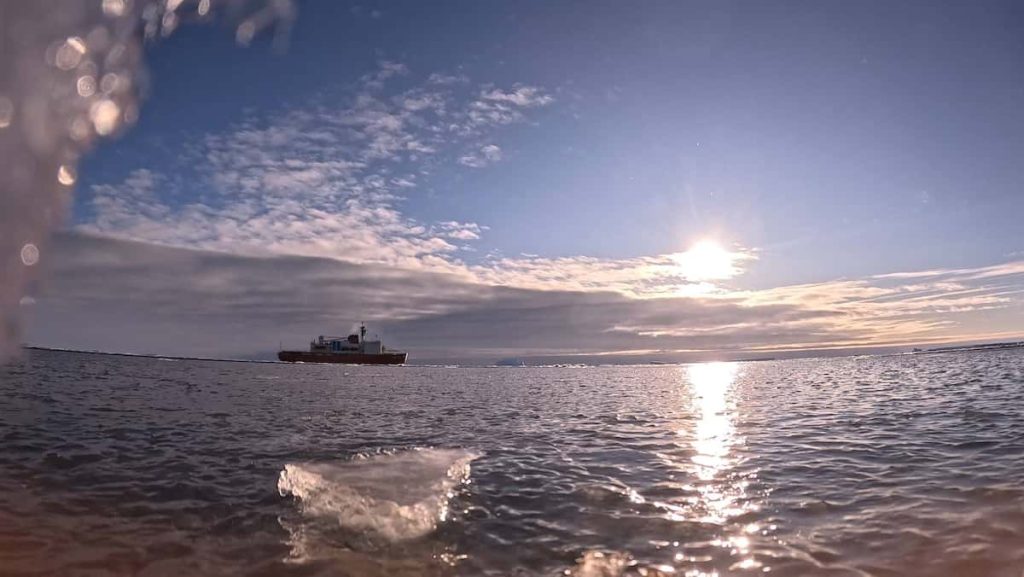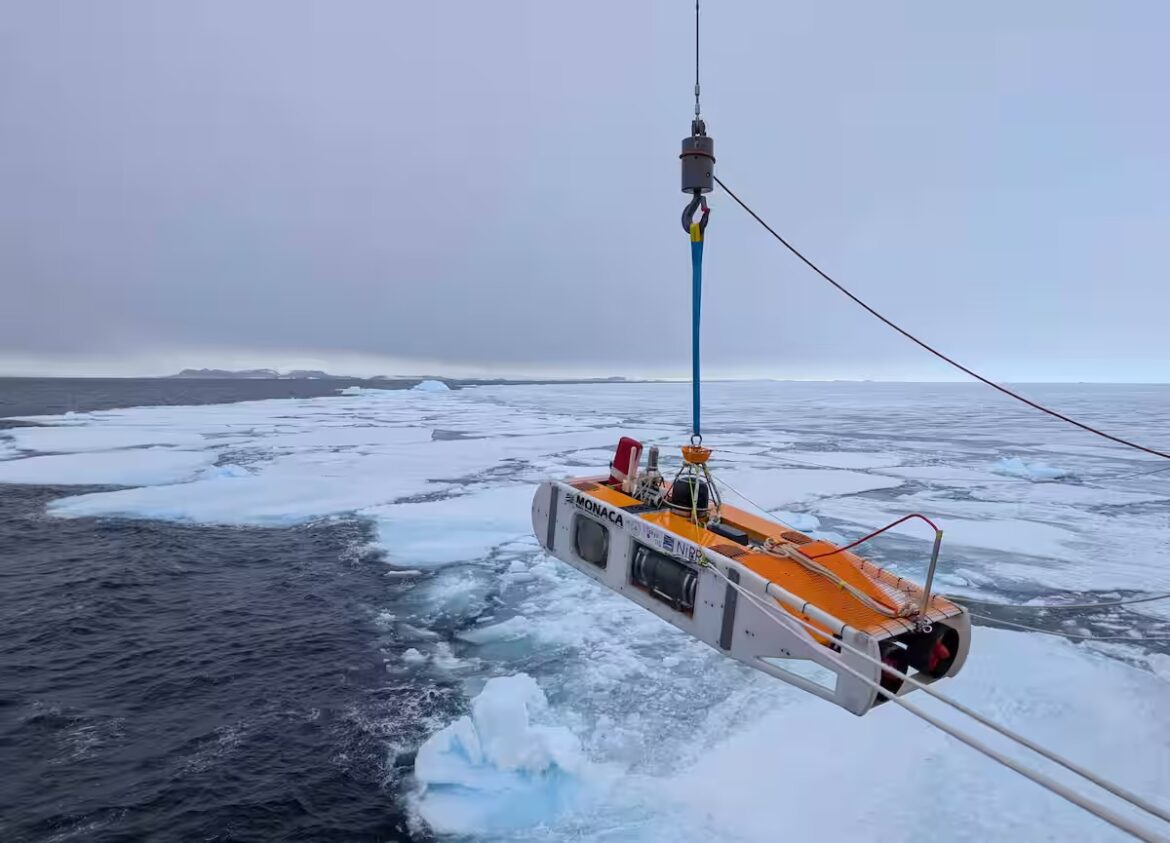A team from the University of Tokyo’s Institute of Industrial Science has successfully used an autonomous underwater vehicle (AUV) to explore beneath the ice in the Southern Ocean off East Antarctica. This region is among the most challenging places on Earth to access.
Melting ice in Antarctica is known to have a major impact on global environmental changes. This achievement is expected to deepen our understanding of those processes.
The team plans to return to Antarctica in the winter of 2025 for further operations. They are also developing new technology to enable the AUV to navigate beneath much thicker ice shelves.
Introducing MONACA
The AUV, named “MONACA,” was jointly developed by the University of Tokyo and the National Institute of Polar Research. It is 2.12 meters long, 65 centimeters wide, and 40 centimeters high (excluding the antenna), and weighs 235 kilograms (518 lbs). It can dive as deep as 1,500 meters (4,920 ft). The vehicle can operate for up to 8 hours and travel as far as 10 kilometers (6.2 miles) beneath the ice.
During the 66th Antarctic Research Expedition in 2024, MONACA was deployed from the Japanese icebreaker Shirase. It operated in two locations: Lützow-Holm Bay, near Japan’s Showa Station off the coast of Africa, and near the Totten Glacier, located opposite Australia.
 The Antarctic research vessel “Shirase,” photographed by the AUV “MONACA” during its mission — March, off Totten Glacier, Antarctica. (Courtesy of the Maki Laboratory, Institute of Industrial Science, University of Tokyo)
The Antarctic research vessel “Shirase,” photographed by the AUV “MONACA” during its mission — March, off Totten Glacier, Antarctica. (Courtesy of the Maki Laboratory, Institute of Industrial Science, University of Tokyo)
Focus on East Antarctica
In February, MONACA traveled about 100 meters on a round-trip in Lützow-Holm Bay, completing the journey in roughly 7 minutes. Then, in March, it completed a 200-meter round-trip near the Totten Glacier in about 14 minutes. In both cases, the distance between the vehicle and the ice above was around 30 meters.
While the United Kingdom, United States, and Australia have already operated AUVs beneath Antarctic ice, this was the first time such missions were carried out in these specific regions. By combining data collected by different countries, researchers can further advance climate-related studies.
Associate Professor Toshihiro Maki, an expert in underwater platform systems at the University of Tokyo, noted that while other countries have focused on West Antarctica, the Japanese team is concentrating on the east. “Ice is melting off the Totten Glacier, but the area hasn’t been studied much,” he said.
 Team members monitoring the AUV “MONACA” aboard the Antarctic research vessel Shirase — February, Lützow-Holm Bay, Antarctica. (Courtesy of the Maki Laboratory, Institute of Industrial Science, University of Tokyo)
Team members monitoring the AUV “MONACA” aboard the Antarctic research vessel Shirase — February, Lützow-Holm Bay, Antarctica. (Courtesy of the Maki Laboratory, Institute of Industrial Science, University of Tokyo)
 Technology for Safe Operation
Technology for Safe Operation
Radio waves do not travel through water, so AUVs must rely on sound waves to communicate and determine their position relative to the mother ship. But when ice is directly overhead, sound waves scatter. If the vehicle malfunctions, it cannot be quickly surfaced and retrieved.
To address this challenge, MONACA is equipped with multiple sonar systems that measure the shape of surrounding objects. It also uses an inertial navigation system to estimate its position and orientation, along with an acoustic positioning device. These tools allow it to operate autonomously and safely. By exchanging acoustic signals with Shirase, it can track its location and maintain a safe distance from the ice above.
The underside of the ice is highly irregular, so MONACA also requires excellent maneuverability to avoid obstacles. Even so, it was difficult to track the vehicle’s position precisely due to the drifting motion of Shirase. Extra care was taken during retrieval to ensure that MONACA did not surface directly beneath the ship.
 The AUV “MONACA” being recovered from the sea by the crane on the Antarctic research vessel Shirase — March, off Totten Glacier, Antarctica. (Courtesy of the Maki Laboratory, Institute of Industrial Science, University of Tokyo)
The AUV “MONACA” being recovered from the sea by the crane on the Antarctic research vessel Shirase — March, off Totten Glacier, Antarctica. (Courtesy of the Maki Laboratory, Institute of Industrial Science, University of Tokyo)
A Window into Global Systems
Antarctica is covered by vast amounts of ice that influence global cycles of heat and water. Studying melting at the base of this ice could lead to a better understanding of climate change.
MONACA is equipped with sensors that measure seawater salinity across wide areas. When ice melts, the salinity of the surrounding water decreases. By tracking these changes, researchers can determine where and how much ice is melting.
There are also plans to eventually capture video from beneath the ice. This could provide new insight into the relationship between sea ice and marine ecosystems.
 Future Missions
Future Missions
In the future, the team plans to study ice shelves — large, floating extensions of glaciers that form over the ocean. Some of these shelves are more than 200 meters (about 656 ft) thick. They play a significant role in the global climate system, and this mission marks a key step toward exploring them.
MONACA is scheduled to participate in the upcoming 67th Antarctic Research Expedition this winter, with plans for longer-distance operations near the Totten Glacier. While no additional Antarctic missions are currently scheduled in the next few years, the team is considering deploying the AUV in the Sea of Okhotsk off Hokkaido during the drift ice season.
RELATED:
(Read the article in Japanese.)
Author: Shinji Ono, The Sankei Shimbun
Continue Reading


AloJapan.com